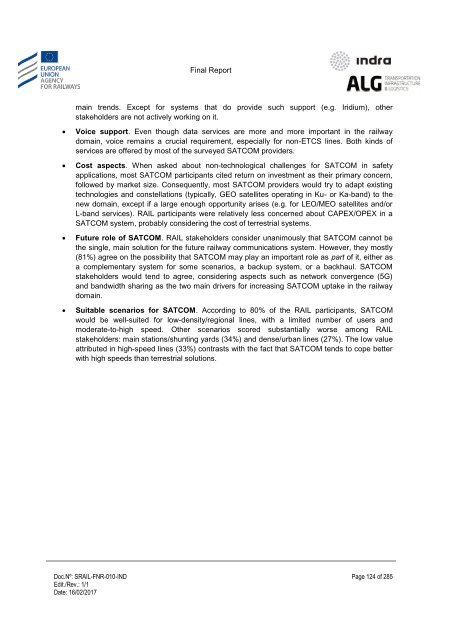Study on feasibility of SATCOM for railway communication
SRAIL-FNR-010-IND%20-%20FinalReport_v1.1_20170216
SRAIL-FNR-010-IND%20-%20FinalReport_v1.1_20170216
Create successful ePaper yourself
Turn your PDF publications into a flip-book with our unique Google optimized e-Paper software.
Final Report<br />
main trends. Except <strong>for</strong> systems that do provide such support (e.g. Iridium), other<br />
stakeholders are not actively working <strong>on</strong> it.<br />
<br />
<br />
<br />
<br />
Voice support. Even though data services are more and more important in the <strong>railway</strong><br />
domain, voice remains a crucial requirement, especially <strong>for</strong> n<strong>on</strong>-ETCS lines. Both kinds <strong>of</strong><br />
services are <strong>of</strong>fered by most <strong>of</strong> the surveyed <strong>SATCOM</strong> providers.<br />
Cost aspects. When asked about n<strong>on</strong>-technological challenges <strong>for</strong> <strong>SATCOM</strong> in safety<br />
applicati<strong>on</strong>s, most <strong>SATCOM</strong> participants cited return <strong>on</strong> investment as their primary c<strong>on</strong>cern,<br />
followed by market size. C<strong>on</strong>sequently, most <strong>SATCOM</strong> providers would try to adapt existing<br />
technologies and c<strong>on</strong>stellati<strong>on</strong>s (typically, GEO satellites operating in Ku- or Ka-band) to the<br />
new domain, except if a large enough opportunity arises (e.g. <strong>for</strong> LEO/MEO satellites and/or<br />
L-band services). RAIL participants were relatively less c<strong>on</strong>cerned about CAPEX/OPEX in a<br />
<strong>SATCOM</strong> system, probably c<strong>on</strong>sidering the cost <strong>of</strong> terrestrial systems.<br />
Future role <strong>of</strong> <strong>SATCOM</strong>. RAIL stakeholders c<strong>on</strong>sider unanimously that <strong>SATCOM</strong> cannot be<br />
the single, main soluti<strong>on</strong> <strong>for</strong> the future <strong>railway</strong> communicati<strong>on</strong>s system. However, they mostly<br />
(81%) agree <strong>on</strong> the possibility that <strong>SATCOM</strong> may play an important role as part <strong>of</strong> it, either as<br />
a complementary system <strong>for</strong> some scenarios, a backup system, or a backhaul. <strong>SATCOM</strong><br />
stakeholders would tend to agree, c<strong>on</strong>sidering aspects such as network c<strong>on</strong>vergence (5G)<br />
and bandwidth sharing as the two main drivers <strong>for</strong> increasing <strong>SATCOM</strong> uptake in the <strong>railway</strong><br />
domain.<br />
Suitable scenarios <strong>for</strong> <strong>SATCOM</strong>. According to 80% <strong>of</strong> the RAIL participants, <strong>SATCOM</strong><br />
would be well-suited <strong>for</strong> low-density/regi<strong>on</strong>al lines, with a limited number <strong>of</strong> users and<br />
moderate-to-high speed. Other scenarios scored substantially worse am<strong>on</strong>g RAIL<br />
stakeholders: main stati<strong>on</strong>s/shunting yards (34%) and dense/urban lines (27%). The low value<br />
attributed in high-speed lines (33%) c<strong>on</strong>trasts with the fact that <strong>SATCOM</strong> tends to cope better<br />
with high speeds than terrestrial soluti<strong>on</strong>s.<br />
Doc.Nº: SRAIL-FNR-010-IND<br />
Edit./Rev.: 1/1<br />
Date: 16/02/2017<br />
Page 124 <strong>of</strong> 285


